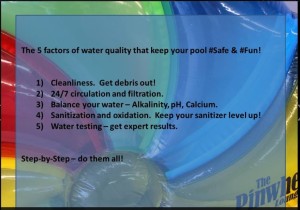In the Laurel Highlands of Western Pennsylvania where we are located, we’ve had a hot, mostly dry run of weather since early July. Now we’re starting to see some waves of frontal rains as cooler air tries to push southward out of Canada. As each impulse comes in, it runs into warmer, more humid air; the interaction – the boundary – becomes a zone of heavy precipitation to be relieved by a spell of still mostly warm, pleasant, and drier air. Yes – there are many more swimming days ahead! So how do you keep your pool water safe, clean, and sparkling with all of this rain, followed by warm sunny days?
We have the 5 Factors that determine the quality and safety of your pool water. Read more here. PS: Cloudy water is Unsafe – but “clear” water isn’t necessarily “safe” water.
- Keep the Pool Clean – Clean out Debris
- Filtration/Circulation – 24/7
- Water Balance
- Sanitization & Oxidation
- Water Testing
However, with rainy weather followed by warm and sunny weather, many people – maybe you too – report having trouble keeping their pools clear. So what can you do to keep your pool clear throughout?
If we had to pick just 1 factor of the 5? Well, we pick Sanitization & Oxidation. Why? Rain water brings with it dissolved and suspended contaminants from the atmosphere, transporting in a combination of living organisms and nutrient material. This rapid influx of material puts a higher-than-normal demand on your sanitization and oxidizer system. The high level of contaminants can quickly use up any residual sanitizer and oxidizer. Unless you take some steps to make sure your pool water has enough of both to last through the onslaught brought on by rain, your pool can get cloudy – quickly. And, once either (or both) your sanitizer and oxidizer are depleted, any remaining contaminants transported in by rain will quickly start growing or feeding growth.
Cloudy pool water following rains is a sign telling you that you’ll get algae growing quickly unless you take action quickly to restore your sanitizer and oxidizer. Since cloudy water is often composed of material that has been affected partially by the sanitization and oxidation process, it is primarily composed of material that has to be broken down. Generally, these materials when fully broken down are gasses that can be transported off into the atmosphere. If you have cloudy water then, you are dealing with a situation where theirs is not enough oxidizer level to break the contaminants into gasses.
To prevent cloudy water, you must bring your oxidizer levels up – if not before the rain, then certainly immediately after. In biguanide pools, bring your oxidizer level toward the upper limit (200 ppm) and maintain it at least greater than 100 ppm. Of course, you want to make sure your sanitizer is topped up to 50 ppm at the same time. In chlorine pools (and, yes, your “salt system” is really just a fancy way of putting chlorine into your pool) keep your free chlorine level toward the high end of the scale, up to 4 ppm.
So the answer is? Shock your pool!
But, did you notice how we had specific amounts of oxidizer you need in your water?
That’s why there are 5 Factors, not 1! Testing, especially accurate testing like we do in our lab, is the only way to measure results accurately. And testing is the only way to tell you for sure how much stuff to add to get the results you want.

